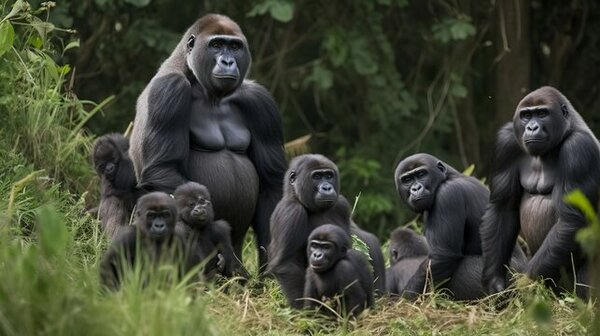Gorillas are among the most iconic and endangered species on our planet. As of recent estimates, the total population of gorillas is around 100,000 individuals, but this number varies significantly depending on the species and their respective habitats. Here’s a closer look at the different types of gorillas and their current population status.

Gorillas are primarily herbivorous, meaning their diet mainly consists of plant-based foods. However, their specific eating habits can vary depending on the species and their natural habitat. Here’s a detailed look at what gorillas eat:
Primary Food Source: Leaves make up a significant portion of a gorilla's diet. They consume a variety of leaves from different plants, which provide essential nutrients.
Types of Leaves: Gorillas often eat leaves from trees, shrubs, and herbs. They prefer younger, tender leaves as they are more nutritious and easier to digest.
Seasonal Delicacy: Fruits are a favorite food for gorillas, especially when they are in season. Gorillas will often travel to find fruit-bearing trees.
Variety: Their diet can include bananas, figs, berries, and other tropical fruits, which are rich in sugars and energy.
Nutrient-Rich: Gorillas also eat stems and new shoots, which are often high in fiber and nutrients. These parts of plants are tender and provide hydration.
Types: Bamboo shoots are particularly favored by some gorilla populations, especially in areas where bamboo is abundant.
Occasional Snack: Gorillas will eat flowers when they are available. While not a primary food source, they provide additional nutrients.
Variety: They may consume the flowers of various plants, including those from fruit trees.
Less Common: While not a major part of their diet, gorillas do dig up and eat roots and tubers when other food sources are scarce.
Energy Source: These underground parts of plants can be calorie-dense and provide energy.
Protein Source: Although gorillas are mainly herbivorous, they will occasionally consume insects like ants and termites. This provides a valuable source of protein.
Frequency: Insect consumption is relatively rare compared to their plant-based diet.
Hydration: Gorillas obtain most of their water from the foods they eat, especially juicy fruits and leaves. However, they will drink from water sources when available.
Foraging: Gorillas spend a significant part of their day foraging for food, often consuming around 40 pounds (18 kg) of vegetation daily.
Social Eating: They are social animals and often feed together, especially in family groups, which can enhance their foraging efficiency.
Gorillas have a diverse and adaptable diet that primarily consists of leaves, fruits, stems, and shoots. Their foraging behavior and dietary preferences play a crucial role in their health and survival. Understanding their dietary habits is essential for conservation efforts and habitat preservation, ensuring these magnificent animals have access to their natural food sources.
Here’s a detailed overview of the different species of gorillas, presented in a table format:
| Gorilla Species | Scientific Name | Description | Habitat | Population Estimate |
|---|---|---|---|---|
| Western Gorilla | Gorilla gorilla | The largest species of gorilla, characterized by a robust build and long arms. | Lowland rainforests and swamps | Approximately 95,000 |
| Western Lowland Gorilla | Gorilla gorilla gorilla | Most numerous and widespread; smaller and lighter than other subspecies. | Central and West Africa | Approximately 90,000 |
| Cross River Gorilla | Gorilla gorilla diehli | The rarest subspecies with a unique genetic makeup; known for its shy behavior. | Nigeria and Cameroon border region | About 200-300 |
| Eastern Gorilla | Gorilla beringei | Characterized by a slightly smaller size than the western species. | Mountainous and lowland forests | Approximately 5,000 |
| Mountain Gorilla | Gorilla beringei beringei | Known for its thick fur and adaptation to cold environments. | Virunga Mountains (Rwanda, Uganda, Democratic Republic of the Congo) | About 1,063 |
| Eastern Lowland Gorilla | Gorilla beringei graueri | The largest of the gorilla subspecies; has a robust body and long limbs. | Eastern Democratic Republic of the Congo | Approximately 3,800 |
Western Gorilla (Gorilla gorilla)
The largest species, recognized for its strength and intelligence.
Found in a variety of habitats, from rainforests to swamps.
Western Lowland Gorilla (Gorilla gorilla gorilla)
The most common subspecies, smaller and more agile than the eastern gorillas.
Primarily inhabits the lowland forests of Central and West Africa.
Cross River Gorilla (Gorilla gorilla diehli)
The most endangered subspecies, with a very limited range.
Lives in dense forests along the Nigeria-Cameroon border.
Eastern Gorilla (Gorilla beringei)
Slightly smaller than the western gorilla but equally robust.
Found in mountainous regions and lower forests.
Mountain Gorilla (Gorilla beringei beringei)
Famous for its thick fur, which helps it survive in colder climates.
A conservation success story, with efforts leading to a gradual increase in population.
Eastern Lowland Gorilla (Gorilla beringei graueri)
The largest subspecies, known for its distinctive features and large size.
Faces significant threats from habitat destruction and poaching
Gorillas are divided into two main species: the Western Gorilla and the Eastern Gorilla, each with its subspecies. Their populations vary widely, and conservation efforts are crucial to ensure their survival, particularly for the more endangered subspecies. Understanding these differences helps in the protection and conservation of these magnificent animals.

Gorillas are among the most intelligent animals in the animal kingdom, showcasing cognitive abilities that are comparable to those of humans. Their intelligence can be observed in various aspects of their behavior, problem-solving skills, social interactions, and communication.
Tool Use: Gorillas have demonstrated the ability to use tools in their natural habitat. For example, they may use sticks to probe for insects or manipulate objects to access food.
Innovative Behavior: In captivity, gorillas have been observed solving complex puzzles and engaging in play that requires planning and foresight. They can figure out how to open enclosures or reach food that is out of their immediate grasp.
Complex Social Structures: Gorillas live in family groups, often led by a dominant silverback male. Their social dynamics require them to navigate relationships, establish hierarchies, and maintain group cohesion, which reflects their understanding of social roles.
Empathy and Emotion: Gorillas show signs of empathy and emotional understanding. They are known to comfort one another during distressing situations, demonstrating their ability to recognize and respond to the emotions of their peers.
Vocalizations and Body Language: Gorillas communicate using a variety of vocalizations, gestures, and facial expressions. Their ability to convey messages and intentions highlights their understanding of social interactions.
Learning Sign Language: Some gorillas, like Koko and Washoe, have been taught elements of American Sign Language. This ability to learn and use human language concepts showcases their cognitive capabilities and understanding of abstract ideas.
Strong Memory: Gorillas possess excellent memory, which aids them in remembering locations of food sources and recognizing other individuals within their social group.
Learning from Experience: They can learn from past experiences, adapting their behavior based on successful or unsuccessful outcomes in various situations.
Cognitive Studies: Research has been conducted to assess gorilla intelligence through various cognitive tests. These studies have revealed their problem-solving skills, understanding of object permanence, and ability to categorize objects.
Captive Studies: Observations in zoos and sanctuaries provide insights into their intelligence. Gorillas in these environments often engage in complex play and social interactions, further highlighting their cognitive abilities
Gorillas are highly intelligent animals, capable of problem-solving, social interaction, and communication. Their cognitive abilities not only reflect their adaptability in the wild but also showcase their emotional depth and social complexity. Understanding gorilla intelligence is essential for conservation efforts, as it emphasizes the need to protect their habitats and ensure their well-being in both the wild and captivity. Their intelligence continues to fascinate researchers and the public alike, reinforcing the importance of studying and conserving these remarkable creatures.

Gorillas and humans share a complex and fascinating relationship, rooted in both biological similarities and cultural significance. Understanding this relationship is crucial for conservation efforts and medical research.
Close Relatives: Gorillas are one of the closest living relatives to humans, sharing about 98% of their DNA with us. This genetic similarity offers insights into human evolution and development.
Health Insights: Studying gorillas can provide valuable information about human health, including genetic disorders, disease susceptibility, and responses to treatments.
Symbol of Conservation: Gorillas are often seen as symbols of wildlife conservation efforts. Their plight has raised awareness about habitat loss, poaching, and the need for conservation strategies.
Educational Value: Gorillas serve as important subjects in educational programs that teach about biodiversity, ecology, and the importance of preserving natural habitats.
Research and Ecotourism: Gorilla tourism has become a significant industry, allowing people to observe these majestic animals in their natural habitats while supporting conservation efforts.
Captive Breeding Programs: Zoos and sanctuaries engage in captive breeding programs to help maintain genetic diversity and protect gorilla populations from extinction.
Gorillas play a vital role in medical research, particularly in fields related to genetics, health, and disease prevention.
Disease Models: Researchers study gorillas to better understand diseases that also affect humans, such as Ebola and tuberculosis. Understanding how these diseases affect gorillas can inform strategies to protect both species.
Immune Response Studies: Investigating how gorillas' immune systems respond to various pathogens can provide insights into human immunology and potential treatments.
Genomic Studies: The genetic similarities between gorillas and humans make them ideal subjects for genomic research. These studies can reveal information about genetic diseases and potential therapies.
Biobank Initiatives: Some conservation organizations maintain biobanks of gorilla DNA and tissue samples for research purposes, aiding in the understanding of species-specific health issues.
Health Monitoring: Regular health assessments of gorillas in the wild and captivity help identify diseases early and monitor the overall health of populations.
Veterinary Research: Research on gorilla health contributes to veterinary medicine, improving care for both wild and captive gorillas and informing broader wildlife health management strategies.
The relationship between gorillas and humans is significant not only from an evolutionary and cultural standpoint but also for medical research. Understanding this relationship enhances conservation efforts and leads to advancements in medical knowledge. By studying gorillas, we can gain insights into human health, improve conservation strategies, and foster a deeper appreciation for these remarkable creatures.
Gorillas are classified as endangered or critically endangered by the International Union for Conservation of Nature (IUCN). The main threats to their survival include:
Habitat Loss: Deforestation for agriculture, logging, and infrastructure development leads to loss of habitat.
Poaching: Gorillas are hunted for bushmeat and captured for the illegal pet trade.
Disease: Outbreaks of diseases, such as Ebola and respiratory infections, can decimate populations.
Human Conflict: War and civil unrest in gorilla habitats can disrupt conservation efforts and increase poaching.
Various organizations and governments are working to protect gorillas through:
Protected Areas: Establishing national parks and reserves to safeguard gorilla habitats.
Anti-Poaching Measures: Implementing patrols and enforcement to combat poaching and illegal wildlife trade.
Community Engagement: Involving local communities in conservation efforts to promote sustainable practices and reduce human-wildlife conflict.
Research and Monitoring: Conducting regular population surveys to track gorilla numbers and health.
While the global population of gorillas is estimated to be around 100,000, the future of these magnificent creatures remains uncertain due to ongoing threats. Conservation efforts are critical to ensuring their survival, and increased awareness and support can help protect these great apes for generations to come.
animal tags: Gorillas
We created this article in conjunction with AI technology, then made sure it was fact-checked and edited by a Animals Top editor.